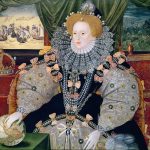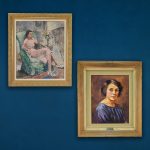Hey everyone! Do you ever feel like you’re being watched? I know I do. Working with paintings that can stare right back at you can be unsettling at times, but portrait paintings have been a part of nearly every auction and deserve a place here in my little corner of blog space. That’s right, this week we’re doing a brief history lesson on portraiture, and I really do mean brief!
 Portraits have been commonplace for centuries, whether it be grand monuments to Pharaohs in Egypt, or depictions of royalty dressed to the nines just to flaunt their wealth and power, we have gained some understanding on what these people looked like. Well, kind of. Like modern day photoshop, the painters were often asked to tweak the portraits to make them look better than they really did. Paintings of Queen Elizabeth I are a great example of this as she was self-conscious of her image and how she presented herself, leading artists and poets to depict her as Diana, Astraea, and Gloriana. Basically, paint her to make her look like an ethereal and chaste queen and not one of your French girls.
Portraits have been commonplace for centuries, whether it be grand monuments to Pharaohs in Egypt, or depictions of royalty dressed to the nines just to flaunt their wealth and power, we have gained some understanding on what these people looked like. Well, kind of. Like modern day photoshop, the painters were often asked to tweak the portraits to make them look better than they really did. Paintings of Queen Elizabeth I are a great example of this as she was self-conscious of her image and how she presented herself, leading artists and poets to depict her as Diana, Astraea, and Gloriana. Basically, paint her to make her look like an ethereal and chaste queen and not one of your French girls.
Another great example is the Habsburgs, even though we have great examples of how they most likely looked due to some artists more accurate portrayals of the family. Due to years of inbreeding, facial deformities and intellectual disabilities were prominent within the family, leading to a condition that is known today as the Habsburg jaw. King Charles II of Spain is considered the most inbred royal and one of the first portraits to come up if you look up the Habsburgs yourself. He was severely disabled and disfigured, but despite this he was still expected to rule. Even so, court painters were asked to tweak their images, especially when it came to marriages, and I do consider this to be catfishing! Thank you, royal families and your false advertising, but if it worked for the Habsburgs it can work for anyone.
accurate portrayals of the family. Due to years of inbreeding, facial deformities and intellectual disabilities were prominent within the family, leading to a condition that is known today as the Habsburg jaw. King Charles II of Spain is considered the most inbred royal and one of the first portraits to come up if you look up the Habsburgs yourself. He was severely disabled and disfigured, but despite this he was still expected to rule. Even so, court painters were asked to tweak their images, especially when it came to marriages, and I do consider this to be catfishing! Thank you, royal families and your false advertising, but if it worked for the Habsburgs it can work for anyone.
Fast forward to the 19th century and the rise of the middle class, artists shied away from exuberance and were beginning to paint working class people. These portraits played an important role in spreading the plight and lives of normal people. Still not exactly looking out for people stuck in poverty but it was a start. Miniature portraits on the other hand were popular from the 16th to mid-19th century, still having a small grasp on society during the 19th century. Small and handheld, they were considered a luxury due to the effort, time, and precision it took to create them. However, with the invention of photography, portrait paintings officially fell out of favor and was ultimately replaced with the more affordable option of portrait photography. Despite this, the skill of portrait artists should not go unpraised or unnoticed! Be sure to check out our March auction and fall in love with our collection of portrait paintings!





